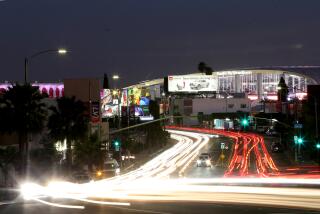Finish the 710 Freeway
In the best case, the political impasse over raising the nation’s debt ceiling would lead to a new political reality for evaluating transportation projects: new rules that favor projects with needs and benefits solidly documented, with proven technology, and that do not push funding obligations onto future generations of taxpayers. The poster child for such a scenario would be the long-debated completion of the 710 Freeway.
The regional need for building the last 4.5 miles of the basic local freeway grid -- between the end of the 710 Freeway in Alhambra and the intersection of the 210 and the 134 freeways -- is beyond any informed dispute. Metropolitan Transportation Authority and Southern California Assn. of Government studies show that this project would offer more relief from congestion and pollution than would any other local highway project. The 218,000 daily vehicle trips postponed or diverted by the 710 gap are nearly half the number of trips affected by the recent closure of the 405 Freeway.
About half of these trips are burdening other freeways, and about half are tying up surface streets. As a result, we face a self-inflicted “Carmageddon” every day. Public polls of 26 cities and political districts find not a city or district in which the majority opposes the tunnel. (South Pasadena and La Canada Flintridge are evenly split.) A review of poll results collected by Godbe Research in 2004 and by the Rose Institute in 2000 shows Los Angeles voters favored completion by 5.6 to one, and San Gabriel Valley residents by 5.7 to one.
Many of the voices that had been against a bulldozed surface connection have been muted by the underground tunnel alternative, which would leave elegant, mature neighborhoods intact. Tunnels are expensive, but they solve problems, and the technology needed for the 710’s tunneling project is proven.
For years, Europe has relied on tunnel links under its dense urban fabric, often funded by private sources and reimbursed by user tolls. For example, the Paris A86 tunnel closed a similar freeway gap, tunneling almost directly under the Palace of Versailles.
Closing the 710 gap is essential from a systems point of view. Complaints about alleged impact on local interests have paralyzed the project for decades, but the stakes have grown with the region.
The MTA board faced the issue squarely on May 27, 2010, making a historic decision to fund an in-depth environmental study for the tunnel option, and finally move ahead. The $59-million study is projected to be completed in three to five years, answering questions of critics and supporters alike regarding alignment, costs, ventilation and, most critically, the dimensions of regional congestion relief. For the first time in decades, no major litigation blocks the 710 project.
Estimates of costs and traffic volumes reveal an opportunity for return on investment: Private sources could very likely be found to pay most of the construction and operation costs, and the public portion of the project could be funded from Measure R monies (approved by voters in 2008 for transportation purposes) and the sale of Caltrans properties in the 710 corridor.
The project, with its estimated 29,000 jobs and air pollution reduction, meets the objectives of Democrats. It fits the Republican agenda by leveraging private resources to attack a public congestion problem and boosting the regional economy by increasing transportation efficiency. Here is what needs to be done to close the gap:
* Purge Congress and the U.S. Department of Transportation from the process. The 710 Freeway is a state route, and it doesn’t need federal dollars or the headaches that come with them.
* Accelerate the environmental review. Cut no corners but stay staffed-up and focused. The review can easily be done in three years or less.
* Maintain the political will to proceed. Focus on the greatest good. Do not pander to that dwindling local faction that accounts for the smallest set of interests but makes the most noise. Enough! Just say no.
* Form a joint powers authority now to jump-start the oversight process. The authority must include the cities in the immediate corridor -- Los Angeles, Alhambra, South Pasadena and Pasadena -- but not those that have interest but no geography in the game. Follow the standard practice of including communities physically adjacent to the planned route. Complete the roster with the agencies most involved in planning, constructing and financing the project: Caltrans, MTA and SCAG.
* And, most important, embrace the toll option. Invite a public-private partnership to design, build and operate the tunnel. Demand for this facility and the benefits from its use will be high. Tolls translate these local benefits into local revenue, local decisions and local control. Costs cannot be carefully estimated until the tunnel is designed, but even rough calculations show that tolls would give private-sector partners a competitive return on investment.
Fifty years of talk is enough. It’s time to dig.
More to Read
Sign up for Essential California
The most important California stories and recommendations in your inbox every morning.
You may occasionally receive promotional content from the Los Angeles Times.










